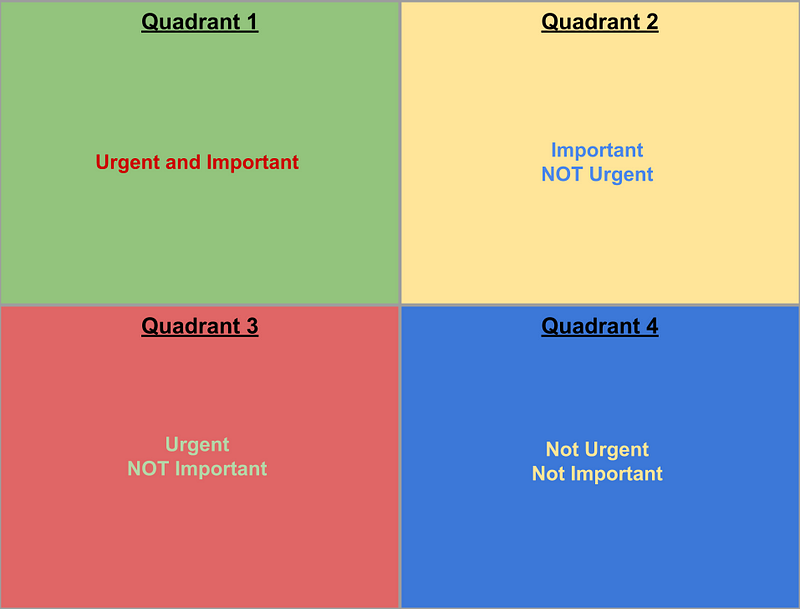Become more confident and decisive — and stop putting things off — using the Eisenhower Matrix

Photo by Artem Verbo on Unsplash
Procrastination is a killer.
It kills projects. It kills opportunities. It can even kill an entire company. It kills slowly and quietly — by sapping your time, energy, and money. It also saps the self-confidence and effectiveness of individuals who could be doing great things.
But it is possible to defeat procrastination. You just have to adopt one simple habit: decisiveness. You have to consistently make decisions and stick with them with a high level of commitment.
How do you do this? It helps first to have an understanding of what procrastination really is. Once you have that understanding, you can adopt a framework for preventing it. The framework helps you make decisions with confidence. You then begin making decisions you’ll stick to. At which point, you’ll stop procrastinating, and start doing great work.
What Is Procrastination?
Procrastination is the putting off of work that you know you should be doing, in favor of something else. In most cases, that “something else” is something you know to be less important. But you do it anyway.
But that’s only a superficial understanding of what procrastination is. Procrastination is an expression of an underlying uncertainty and anxiety. You’re uncertain about whether that thing you’ve told yourself you need to do is actually the most important thing you could be doing.
In short, you made an earlier decision to do a thing, believing it to be important. But as you consider starting work on it, you stop. You get distracted. You space out, you look at your inbox again. Why?
Your brain is trying to tell you something. It’s trying to tell you that it knows there’s other stuff out that — stuff you should be doing. And something in that amorphous blog of other stuff is more important. But that blob of stuff is so dense, you don’t have the energy to look through it now and decide what you really should be doing. So you do nothing.
But if you had already looked at that blob — and decided which things in it were important and which weren’t — you’d be confident in your decision. Unless something more important or more urgent came along, you would do that thing you identified was a priority. To do this, you need a decision-making process. Enter the Eisenhower Matrix.
The Eisenhower Matrix
The most effective way to get clear on priorities is something called the Eisenhower Matrix. It’s a simple framework that makes it easy to make decisions about priorities that you’ll stick to.
It’s simple enough to learn in minutes. It’s agile enough to use with any tools — be they paper-based or digital. It’s also flexible enough to accommodate both big goals or projects and smaller tasks.
The idea behind it is simple: everything you believe you need to do goes in 1 of 4 quadrants on a matrix. Spend as much time as you can in the first 2 quadrants — spending as much time as you can on quadrant 2 stuff.

The Eisenhower Matrix, c/o the author
But what are these quadrants? They’re really just different combinations of two concepts: urgency and importance. The matrix has 4 quadrants:
- Quadrant 1: Urgent and Important stuff
- Quadrant 2: Important, but not urgent stuff
- Quadrant 3: Urgent, but not Important stuff
- Quadrant 4: Neither urgent nor important stuff
Understanding the difference between urgency and importance is the key to this framework. But once you do understand, you can supercharge how effective you are at making decisions. Which makes you much less likely to become uncertain about priorities. Which in turn makes you much less likely to procrastinate.
What does Urgent mean?
Something is urgent when it is time sensitive. It must be done as soon as possible or there will be negative consequences. The urgency can come from someone else’s constraints or ones you place upon yourself. Either way, if something is urgent, it requires immediate attention, time, and energy.
Urgent things on your plate tend to be smaller, simpler, shorter-duration tasks. They also tend to be newer on your list of things to do, because they arrive to you with a built-in demand for quick action.
What does Important Mean?
Important things, unlike urgent ones, aren’t time sensitive. They may have deadlines or desired dates, but they are often further away. Things that are important contribute to larger, often higher-level goals. Sometimes they are fixes to persistent problems. Other times, they are pivots or massive innovations.
Whatever specific form they take, important things are worth doing, and beneficial to you. But they require some self-motivating, because they’re often drowned out by the loudness of urgent things. The urgent tasks will often butt in line ahead of important ones in our brains. That trend is what makes prioritization so necessary. If you don’t force yourself to attend to important work, you’ll spend all your time and energy on the consistent onslaught of the urgent.
Using the Eisenhower Matrix as a Weapon
The Eisenhower Matrix works by getting you to do 2 things:
- Classify your stuff to do based on its level of urgency and importance.
- Work on your tasks in priority order — based on that urgency and importance. Begin with Quadrant 1, then 2, and so on.
That’s where the quadrants come into play. They have numbers for a reason. That’s the priority order of work.
Quadrant 1, the urgent and important, should get your attention right away. Attend to those items until they’re done or downgraded. If you can, delegate some part of those things, to help get them done more quickly — since they are urgent.
Quadrant 2, the important but not urgent, should get your attention next. But there’s an important point to make here. Though quadrant 1 is where you go first, quadrant 2 stuff should be where you go most. That is to say: quadrant 2 items should get most of your time and attention. After all, those items feed into your long-term goals. They deserve a lot of attention.
And rarely are your long-term goals urgent. In fact, failing to do the important stuff, while you toil away at the ever-present urgent stuff, is a common reason why people fail to achieve their goals. Don’t let it happen to you; focus on quadrant 2 stuff as much as you can. Make time for the important.
Quadrants 3 and 4 deserve little attention here. But they can be a source of distraction for many of us. I would suggest you pay as little attention to quadrant 4 items as you can. After all, you identified them as neither urgent nor important. So why give them any time and attention? On to quadrant 3.
Quadrant 3 items (the urgent but not important) can be alluring. They can trick us into thinking we need to do them immediately. They’re often not individually time-consuming, but there tend to be a lot of them. So they add up.
A big part of overcoming procrastination is realizing that quadrant 3 items are not important. Someone may want them done now, but they provide little value in the long run. If you do this right, you can start a quadrant 2 project to do something the prevent these quadrant 3 activities from being so prevalent. That brings us to a sneaky power inherent in working the matrix: the secret power of quadrant 2.
The Power of Quadrant 2
If you were to track how much time you spend on stuff in each quadrant, you’ll likely find that you spend the most time in quadrant 1. Perhaps you even spend a lot of time in quadrant 3. And that’s a big reason why you procrastinate, or feel overwhelmed and unmotivated.
Doing urgent stuff (quadrants 1 and 3) with most of your time takes away from your sense of agency and self-actualization. Rather than doing work that you have identified as important, you are at the beck and call of others. Rather than working at your own pace, you are being pushed by the deadlines and demands of the deadlines. Rather than working on things with a clear return on investment, you’re working merely to avoid catastrophe. That gets exhausting.
If you were to spend significant time on quadrant 2 activities, you’d see something interesting. Many of your urgent items in quadrant 1 stop coming up. You may find that 90% of the urgent items that pop up could have been prevented by proactive quadrant 2 activities. Think of how many quadrant 1 items are paired with you slapping your forehead remembering that you should have started that weeks ago?
All this is to say that the more time you spend on identifying and working on quadrant 2 activities, the less time you will procrastinate. Getting clear on the importance and urgency of your stuff, and working it in priority order, will minimize your indecisive mind.
The Simple Summary
We’ve identified why we procrastinate: we’re indecisive. We’re indecisive because we haven’t prioritized our work. Using the Eisenhower Matrix, you can prioritize your work, and stop second-guessing yourself when it’s time to do it. When you stop second-guessing yourself, you will stop procrastinating. So use the method:
- Categorize your tasks and projects into an Eisenhower Matrix, based on the 4 quadrants of urgency and importance.
- Work on the stuff in your quadrants in numerical order, from quadrant 1 down.
- Spend as much time as you can on quadrant 2 items.
- Keep categorizing and recategorizing, so you don’t second-guess the priority of your work.